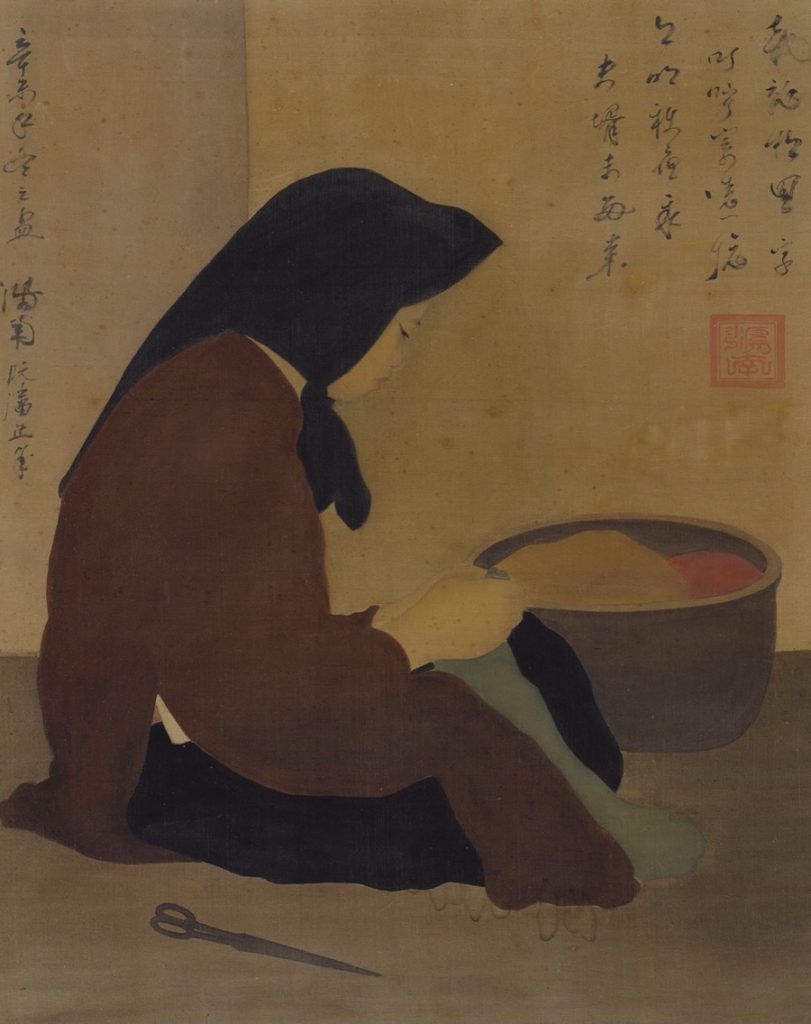Nguyen Phan Chanh, 1931, « La Couture », or the feeling of the gesture must be the gesture of the feeling
The Paris Colonial Exhibition, which closed on November 15, 1931, allowed Victor Tardieu’s School of Fine Arts to acquire an international audience and to seduce other collectors beyond the circles of Hanoi. This is a significant achievement, as six years after the first class was launched, many students were not yet graduated, but were still important suppliers of works for the Colonial Exhibition.
The AGINDO (Indochina Economic Agency), under the authority of Paul Blanchard de la Brosse (1872-1945), continued its patient work of promoting Vietnamese painting in the heart of Paris, a demanding “city of light” with most of the world’s artistic production of the time concentrated there.

The composition of our gouache and ink on silk is classic in Nguyen Phan Chanh, a triangle with a hemispherical figure (the three zones in black ink for the clothes of the character and the box) and particularly simple objects: a box, a pair of scissors on the ground, a character in profile, an “anonymous” place, a suspended gesture. The cameo of brown that structures the space characterizes the years of grace (1929-1934).
This choice of cameo will be criticized: Blanchard de la Brosse informed Victor Tardieu of the tendencies shown by buyers and suggested improvements to be made. In a letter dated October 24, 1933, two years after our silk he mentioned the preference given by “Minister Balinier” to a painting by Nam Son rather than to “The Soothsayer” by Nguyên Phan Chanh:
“This incident confirms the tendency of French connoisseurs to seek out color. As evocative of Tonkin Chanh’s paintings can be with remarkable and undeniable qualities, I realize they do not please the public very much. It is desirable that, more and more, this excellent artist cultivates on his palette more shimmering colors or that we have the means, when presenting his paintings, to frame them with works that are colorful enough to break their monotony.“
Certainly Blanchard de la Brosse, lucid and eclectic, noted, very early on, that Nam Son was a minor artist compared to Nguyen Phan Chanh but seemed to show there a certain pastism… Certainly informed by Tardieu, Nguyen Phan Chanh painted “The Girl with the Parrot” in 1933, a work that will remain unique by its colorization because his later production will show a renewed fidelity to cameo.
The date and signature in the upper left corner are classic, as are the stamp in the middle right corner and the format (65 cm X 50 cm).
The poem is rarer. I have listed about 20 “silks” by Nguyen Phan Chanh made between 1929 and 1936 and held 18 of them in my hands. Only 6 (counting the isolated poetic phrases) contain a poem.
The text is obviously inspired by “Chinh phu ngâm” (written by Dang Tran Con, around 1740) much more than by “Kim Vân Kieû” (written by Nguyen Du, probably in 1813) for example.

It is here the melancholy of a wife far from her husband and not the tragedy of a woman braving her destiny. It is an interview at a distance, nourished by austerity, not a series of typical characters exalting their destiny.
In a beautiful calligraphy the painter writes:
裁就相思字,
叮咛寄远怀。
月明秋夜永,
夫婿未归来”
“I have sewn my love into the clothes made for you.
I repeat thousands of words to express my concern for your long journey.
This autumn night sky with a bright moon seems to never die,
But my husband has not yet returned.”
Here the wife is not that of a mandarin and yet the nobility of feeling is the same. For Nguyen Phan Chanh the gesture takes precedence over the spirit. The mandarin’s wife and the modest peasant woman each express a feeling of equal value. For Phan Chanh, and this is the basis of his work, the gesture is significant because the spirit is signified. This supposes the primacy of the individual in the value of the act.
The war of independence (1946-1954) that he supported implied the fusion of the individual in the service of the group, which he accepted for the duration of the war. But the new ideology imposed after 1954 will require the drastic negation of the individual what he will not be able to admit. His work will suffer deeply.
In this year 1931, Nguyen Phan Chanh affirms it: the feeling of the gesture must be the gesture of the feeling.
Jean-François Hubert